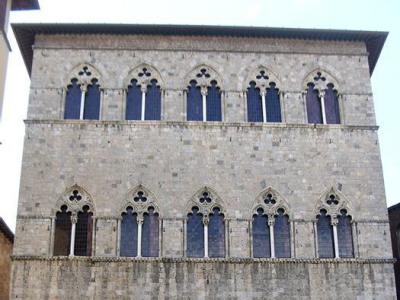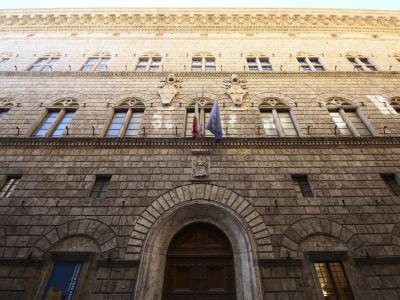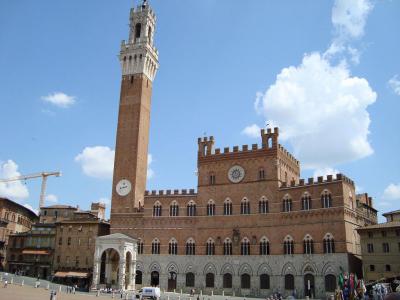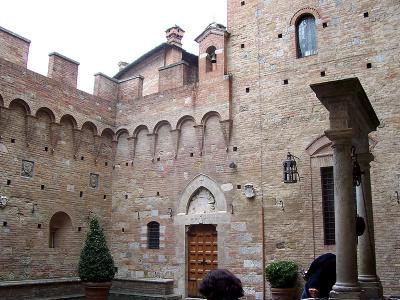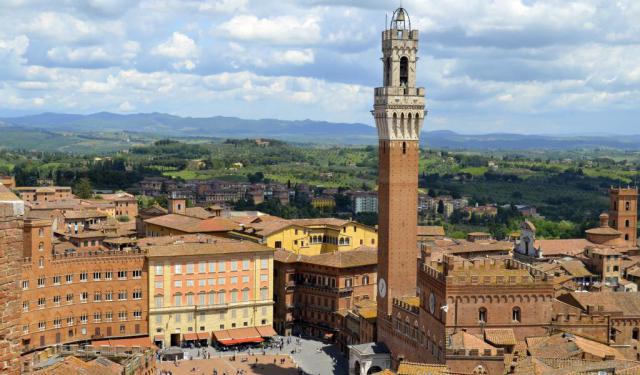
Siena's Palaces Walking Tour (Self Guided), Siena
A leisurely stroll through downtown Siena – a designated UNESCO World Heritage Site, full of imperious castles, palaces and other historic buildings – promises an exciting day of discovery and a pleasant experience for architecture buffs.
While most Italian cities have a church on their main square, Siena's famous Piazza Del Campo gathers around the city hall, known as Palazzo Pubblico (literally the “Public Palace”) – symbol of rational government, and a tall municipal tower (open for climbers). If it's true that a society builds its tallest towers to its greatest gods, then it seems like the people of Siena worship secular effectiveness more than they trust in God. Other than being the seat of the municipal administration, this 13th-century building also plays host to an art museum.
A 14th-century urban fortress, remodeled in the 19th century with the triple mullioned windows inspired by Palazzo Pubblico, Palazzo Salimbeni is a neo-Gothic-style edifice flanking a piazza of the same name. The palace currently serves as the headquarters of Monte dei Paschi di Siena, the most ancient bank in the world, founded twenty years before Christopher Columbus discovered America.
Palazzo Tolomei (Tolomei Palace) – one of the oldest and most beautiful private residences in Siena; carefully restored in 1971.
Palazzo Piccolomini (Piccolomini Palace) – a Renaissance-style palace built between 1460 and 1495; today houses the State Archive.
Palazzo Chigi Saracini (Chigi Saracini Palace) – one of the most noble palaces in the city; home to a valuable private art collection and the prestigious Accademia Musicale Chigiana.
If you're keen to acquaint yourself with the palatial side of Siena more closely, take this self-guided walking tour.
While most Italian cities have a church on their main square, Siena's famous Piazza Del Campo gathers around the city hall, known as Palazzo Pubblico (literally the “Public Palace”) – symbol of rational government, and a tall municipal tower (open for climbers). If it's true that a society builds its tallest towers to its greatest gods, then it seems like the people of Siena worship secular effectiveness more than they trust in God. Other than being the seat of the municipal administration, this 13th-century building also plays host to an art museum.
A 14th-century urban fortress, remodeled in the 19th century with the triple mullioned windows inspired by Palazzo Pubblico, Palazzo Salimbeni is a neo-Gothic-style edifice flanking a piazza of the same name. The palace currently serves as the headquarters of Monte dei Paschi di Siena, the most ancient bank in the world, founded twenty years before Christopher Columbus discovered America.
Palazzo Tolomei (Tolomei Palace) – one of the oldest and most beautiful private residences in Siena; carefully restored in 1971.
Palazzo Piccolomini (Piccolomini Palace) – a Renaissance-style palace built between 1460 and 1495; today houses the State Archive.
Palazzo Chigi Saracini (Chigi Saracini Palace) – one of the most noble palaces in the city; home to a valuable private art collection and the prestigious Accademia Musicale Chigiana.
If you're keen to acquaint yourself with the palatial side of Siena more closely, take this self-guided walking tour.
How it works: Download the app "GPSmyCity: Walks in 1K+ Cities" from Apple App Store or Google Play Store to your mobile phone or tablet. The app turns your mobile device into a personal tour guide and its built-in GPS navigation functions guide you from one tour stop to next. The app works offline, so no data plan is needed when traveling abroad.
Siena's Palaces Walking Tour Map
Guide Name: Siena's Palaces Walking Tour
Guide Location: Italy » Siena (See other walking tours in Siena)
Guide Type: Self-guided Walking Tour (Sightseeing)
# of Attractions: 5
Tour Duration: 1 Hour(s)
Travel Distance: 0.7 Km or 0.4 Miles
Author: irenebo
Sight(s) Featured in This Guide:
Guide Location: Italy » Siena (See other walking tours in Siena)
Guide Type: Self-guided Walking Tour (Sightseeing)
# of Attractions: 5
Tour Duration: 1 Hour(s)
Travel Distance: 0.7 Km or 0.4 Miles
Author: irenebo
Sight(s) Featured in This Guide:
- Palazzo Salimbeni (Salimbeni Palace)
- Palazzo Tolomei (Tolomei Palace)
- Palazzo Piccolomini (Piccolomini Palace)
- Palazzo Pubblico (Public Palace)
- Palazzo Chigi Saracini (Chigi Saracini Palace)
1) Palazzo Salimbeni (Salimbeni Palace)
Salimbeni Palace (Palazzo Salimbeni), located in Siena, is a historically significant building that dates back to the 14th century. Originally built as a fortress, the palace flanks a piazza sharing its name and has undergone several transformations over the centuries.
The palace was originally erected on the site of an even older structure from the 12th century and served as the residence of the Salimbeni family until their expulsion from the city in 1419. Following this, the city council acquired the building and eventually sold it in 1866 to Monte dei Paschi di Siena, one of Italy's major banks, which continues to use it as its headquarters.
Architecturally, the Salimbeni Palace initially featured a medieval fort-like appearance, characteristic of the Sienese Gothic style. In 1879, the building underwent a significant remodel overseen by Giuseppe Partini, who infused it with a neo-Gothic aesthetic. This renovation expanded the building's size and preserved certain original elements like the battlements on the roof and the arches below, which were part of the original medieval structure.
The building was modernized once again in 1959 to accommodate the modern needs of the bank's offices. Over the years, Monte dei Paschi di Siena has enriched the palace’s interior with numerous works of art from renowned artists such as Beccafumi, Pietro Lorenzetti, and Sassetta. Additionally, the bank has assembled a significant collection of valuable documents that chronicle the economic history of Siena, housed within its archives.
Today, Salimbeni Palace not only serves as a functional space for its banking operations but also stands as a testament to the rich historical and cultural heritage of Siena.
The palace was originally erected on the site of an even older structure from the 12th century and served as the residence of the Salimbeni family until their expulsion from the city in 1419. Following this, the city council acquired the building and eventually sold it in 1866 to Monte dei Paschi di Siena, one of Italy's major banks, which continues to use it as its headquarters.
Architecturally, the Salimbeni Palace initially featured a medieval fort-like appearance, characteristic of the Sienese Gothic style. In 1879, the building underwent a significant remodel overseen by Giuseppe Partini, who infused it with a neo-Gothic aesthetic. This renovation expanded the building's size and preserved certain original elements like the battlements on the roof and the arches below, which were part of the original medieval structure.
The building was modernized once again in 1959 to accommodate the modern needs of the bank's offices. Over the years, Monte dei Paschi di Siena has enriched the palace’s interior with numerous works of art from renowned artists such as Beccafumi, Pietro Lorenzetti, and Sassetta. Additionally, the bank has assembled a significant collection of valuable documents that chronicle the economic history of Siena, housed within its archives.
Today, Salimbeni Palace not only serves as a functional space for its banking operations but also stands as a testament to the rich historical and cultural heritage of Siena.
2) Palazzo Tolomei (Tolomei Palace)
The Tolomei Palace is one of the oldest private palaces in Siena. It was carefully restored in 1971 and is one of the most beautiful among the grand residences of the city.
The Tolemei Palace was commissioned in the year 1208 for Jacopo di Rinaldo Tolomei. The Tolomeis were a wealthy banking family who traced their origins to Egypt. They were descendants of the kings of Egypt and came to Italy with Charlemagne. They received patronage from many churches in the city including the nearby church of Saint Christopher. The family was driven out of the city in 1267 and their residence was damaged by the Ghibellines after the Battle of Montaperti. It was restored shortly after between the years 1270 and 1272.
The Tolemei Palace has a well preserved Gothic style stone façade that was typical of palaces in the 13th century. Two lines of elaborate double lighted windows look over a wide central portal. The large stone building has pointed arches and has two floors. The symbol of the Tolemei family consisting of three upright crescents and an upturned triangle is carved on the façade above the portal and above the two doors. The Tolemei Palace today houses a bank and several offices.
The Tolemei Palace was commissioned in the year 1208 for Jacopo di Rinaldo Tolomei. The Tolomeis were a wealthy banking family who traced their origins to Egypt. They were descendants of the kings of Egypt and came to Italy with Charlemagne. They received patronage from many churches in the city including the nearby church of Saint Christopher. The family was driven out of the city in 1267 and their residence was damaged by the Ghibellines after the Battle of Montaperti. It was restored shortly after between the years 1270 and 1272.
The Tolemei Palace has a well preserved Gothic style stone façade that was typical of palaces in the 13th century. Two lines of elaborate double lighted windows look over a wide central portal. The large stone building has pointed arches and has two floors. The symbol of the Tolemei family consisting of three upright crescents and an upturned triangle is carved on the façade above the portal and above the two doors. The Tolemei Palace today houses a bank and several offices.
3) Palazzo Piccolomini (Piccolomini Palace)
The Piccolomini Palace (Palazzo Piccolomini) is an emblematic Renaissance-style palace situated in the heart of Siena. Nestled along the Banchi di Sotto and cornering Rinaldini Street (Via Rinaldini), this historic structure is strategically positioned uphill and west of notable landmarks such as the church of San Martino, the Loggia del Papa, and the Papesse Palace (Palazzo delle Papesse), the latter also having connections to the influential Piccolomini family.
Constructed between 1460 and 1495, the Piccolomini Palace was commissioned by Giacomo and Andrea Piccolomini, nephews of Pope Pius II. They entrusted the architectural design to Bernardo Rossellino, whose vision was inspired by prominent Florentine palaces such as the Palazzi Medici Riccardi and Ruccellai. Characteristic features of the palace include its rough ashlar block surface and mullioned windows, a hallmark of Renaissance aesthetics. The sculptural embellishments, a significant aspect of the building's grandeur, were executed by notable artists Antonio Federighi and Urbano da Cortona.
In 1884, the palace underwent a significant transformation when it was acquired and refurbished by the Bank of Italy. During the 19th century, the Piano Nobile was adorned with neo-Renaissance frescoes, crafted under the artistic direction of Augusto Corbi, enhancing the historical and aesthetic value of the palace.
Today, the Piccolomini Palace serves as a contemporary art gallery and museum, offering a vibrant cultural venue within its historic walls. Visitors can explore its diverse art collections and enjoy breathtaking views from the palace's terrace on the second floor, which overlooks the medieval town and provides a picturesque panorama of the Siena Duomo. Further elevating its charm is a rooftop loggia positioned at the highest point of the palace, offering expansive views of the surrounding Tuscan landscape.
Directly across the street, the Palazzo Piccolomini-Clementini, styled in Gothic architecture, stands on Via di Banchi Sotto, adding to the architectural diversity and historical narrative of the area. Together, these structures encapsulate a significant portion of Siena's rich heritage and architectural evolution, making the Palazzo Piccolomini a cornerstone of cultural and historical exploration in Tuscany.
Constructed between 1460 and 1495, the Piccolomini Palace was commissioned by Giacomo and Andrea Piccolomini, nephews of Pope Pius II. They entrusted the architectural design to Bernardo Rossellino, whose vision was inspired by prominent Florentine palaces such as the Palazzi Medici Riccardi and Ruccellai. Characteristic features of the palace include its rough ashlar block surface and mullioned windows, a hallmark of Renaissance aesthetics. The sculptural embellishments, a significant aspect of the building's grandeur, were executed by notable artists Antonio Federighi and Urbano da Cortona.
In 1884, the palace underwent a significant transformation when it was acquired and refurbished by the Bank of Italy. During the 19th century, the Piano Nobile was adorned with neo-Renaissance frescoes, crafted under the artistic direction of Augusto Corbi, enhancing the historical and aesthetic value of the palace.
Today, the Piccolomini Palace serves as a contemporary art gallery and museum, offering a vibrant cultural venue within its historic walls. Visitors can explore its diverse art collections and enjoy breathtaking views from the palace's terrace on the second floor, which overlooks the medieval town and provides a picturesque panorama of the Siena Duomo. Further elevating its charm is a rooftop loggia positioned at the highest point of the palace, offering expansive views of the surrounding Tuscan landscape.
Directly across the street, the Palazzo Piccolomini-Clementini, styled in Gothic architecture, stands on Via di Banchi Sotto, adding to the architectural diversity and historical narrative of the area. Together, these structures encapsulate a significant portion of Siena's rich heritage and architectural evolution, making the Palazzo Piccolomini a cornerstone of cultural and historical exploration in Tuscany.
4) Palazzo Pubblico (Public Palace) (must see)
The Public Palace was completed in 1308 after being commissioned by the Council of Nine. It is a fine example of traditional Italian medieval architecture. The first floor is light-colored stone, and the upper floors are made of red brick. The facade is slightly curved inwards to reflect the curve of the Campo Square.
In the center of the facade, you will notice a round bronze plate. The Christogram plate was placed in 1425 to honor Saint Bernardino, whose sermons eased social unrest.
The triforate windows are an architectural specialty unique to Siena. The windows are divided with three arches resting on columns. Visitors will also notice the balzana, or coat of arms of the Town Council of Siena.
The attached bell tower, Mangia Tower, was completed in 1348. It stands at 102 meters, the same height as the Siena Cathedral. The height is also equal to the radius of the square. This was deliberate to show that the church and the state had equal power. The Mangia Tower has a gray upper loggia and a red brick base.
The Piazza Chapel was added in 1352 and features marble statues. The lower loggia was added to fulfill a promise that Black Death survivors made to the Holy Virgin. Visitors can climb the Mangia Tower for panaramic views of Siena.
The Public Palace housed the Council of Nine, who were chosen from the general public by lot. The Council of Nine lived in the palace to avoid outside influence and served for just two months before being replaced by the next set of members. The Public Palace also housed the 500 parliamentary members known as the Grand Council.
The internal courtyard is decorated with the coat of arms of families who served on the Council of Nine. Here, you can enter the Civic Museum and see all the world-class frescoes.
Why You Should Visit:
The Public Palace is the crown of Campo Square and a great example of Siena's impressive architecture.
Tips:
You can purchase a combined ticket to climb the Mangia Tower and visit the Civic Museum. Arrive early as the tower tickets sell out fast.
In the center of the facade, you will notice a round bronze plate. The Christogram plate was placed in 1425 to honor Saint Bernardino, whose sermons eased social unrest.
The triforate windows are an architectural specialty unique to Siena. The windows are divided with three arches resting on columns. Visitors will also notice the balzana, or coat of arms of the Town Council of Siena.
The attached bell tower, Mangia Tower, was completed in 1348. It stands at 102 meters, the same height as the Siena Cathedral. The height is also equal to the radius of the square. This was deliberate to show that the church and the state had equal power. The Mangia Tower has a gray upper loggia and a red brick base.
The Piazza Chapel was added in 1352 and features marble statues. The lower loggia was added to fulfill a promise that Black Death survivors made to the Holy Virgin. Visitors can climb the Mangia Tower for panaramic views of Siena.
The Public Palace housed the Council of Nine, who were chosen from the general public by lot. The Council of Nine lived in the palace to avoid outside influence and served for just two months before being replaced by the next set of members. The Public Palace also housed the 500 parliamentary members known as the Grand Council.
The internal courtyard is decorated with the coat of arms of families who served on the Council of Nine. Here, you can enter the Civic Museum and see all the world-class frescoes.
Why You Should Visit:
The Public Palace is the crown of Campo Square and a great example of Siena's impressive architecture.
Tips:
You can purchase a combined ticket to climb the Mangia Tower and visit the Civic Museum. Arrive early as the tower tickets sell out fast.
5) Palazzo Chigi Saracini (Chigi Saracini Palace)
The Chigi Saracini Palace (Palazzo Chigi Saracini), nestled in the heart of Siena, stands as a remarkable testament to the rich historical and cultural evolution of the region. Originally constructed in the mid-12th century, this medieval palace initially belonged to the affluent Marescotti family. Over the centuries, it underwent several ownership changes and renovations that have shaped its architectural and artistic character.
In 1506, the Piccolomini-Mandoli family acquired the palace, transforming its façade with Renaissance elements that introduced a new artistic epoch to the structure. The palace experienced another significant transformation in 1770 when it was purchased by the Saracini family. This era not only marked further architectural enhancements, aligning the façade with the street line but also the beginning of its journey as a cultural repository. The Saracini family amassed a diverse and exquisite collection of artworks, including statues, bas-reliefs, paintings, and ceramics, alongside artifacts crafted from ivory, wood, and precious stones. Noteworthy pieces from the Renaissance through the 18th century, featuring works by eminent artists such as Botticelli, Sodoma, and Sassetta, now grace the palace’s interiors.
In the early 20th century, the palace was inherited by Fabio Chigi Lucarini Saracini, who founded the prestigious Chigiana Music Academy (Accademia Musicale Chigiana) in 1932 within its walls. This academy quickly became one of Italy’s most esteemed musical institutions, nurturing the talents of celebrated musicians like Carlo Maria Giulini, Salvatore Accardo, and Claudio Abbado.
Today, Chigi Saracini Palace is not only a hub for classical music education but also a cherished historical site. Visitors can explore this magnificent palace through guided tours, offering a glimpse into its grand past and the eclectic art collection of Count Galgano Lucarini Saracini. The Chigi Saracini Palace, therefore, serves as a vibrant center of art and music, bridging the medieval with the modern, and continuing to celebrate and inspire the cultural landscape of Siena.
In 1506, the Piccolomini-Mandoli family acquired the palace, transforming its façade with Renaissance elements that introduced a new artistic epoch to the structure. The palace experienced another significant transformation in 1770 when it was purchased by the Saracini family. This era not only marked further architectural enhancements, aligning the façade with the street line but also the beginning of its journey as a cultural repository. The Saracini family amassed a diverse and exquisite collection of artworks, including statues, bas-reliefs, paintings, and ceramics, alongside artifacts crafted from ivory, wood, and precious stones. Noteworthy pieces from the Renaissance through the 18th century, featuring works by eminent artists such as Botticelli, Sodoma, and Sassetta, now grace the palace’s interiors.
In the early 20th century, the palace was inherited by Fabio Chigi Lucarini Saracini, who founded the prestigious Chigiana Music Academy (Accademia Musicale Chigiana) in 1932 within its walls. This academy quickly became one of Italy’s most esteemed musical institutions, nurturing the talents of celebrated musicians like Carlo Maria Giulini, Salvatore Accardo, and Claudio Abbado.
Today, Chigi Saracini Palace is not only a hub for classical music education but also a cherished historical site. Visitors can explore this magnificent palace through guided tours, offering a glimpse into its grand past and the eclectic art collection of Count Galgano Lucarini Saracini. The Chigi Saracini Palace, therefore, serves as a vibrant center of art and music, bridging the medieval with the modern, and continuing to celebrate and inspire the cultural landscape of Siena.
Walking Tours in Siena, Italy
Create Your Own Walk in Siena
Creating your own self-guided walk in Siena is easy and fun. Choose the city attractions that you want to see and a walk route map will be created just for you. You can even set your hotel as the start point of the walk.
Siena Old Town Walking Tour
Siena was originally settled by Etruscans of Italy and later settled by Romans, who emulated Etruscan culture and named the city Sena Julia. The Lombard Kings then developed the city. By the 12th century, Siena was self-governing.
Siena established the Council of Nine in 1270. This Council was responsible for a flourishing economy, a focus on art, and a building boom. In 1348, Siena was... view more
Tour Duration: 1 Hour(s)
Travel Distance: 1.1 Km or 0.7 Miles
Siena established the Council of Nine in 1270. This Council was responsible for a flourishing economy, a focus on art, and a building boom. In 1348, Siena was... view more
Tour Duration: 1 Hour(s)
Travel Distance: 1.1 Km or 0.7 Miles
Medieval Siena Walking Tour
Siena is a beautiful medieval city whose Gothic-era identity, acquired between the 12th and 15th centuries, has been successfully preserved due to the centuries of political and economic irrelevance in the shadow of its grander neighbor Florence. Today's Siena is a cultural gold mine and ideal place to revel in medieval Italy.
No tour of Siena is complete without visiting its heart, the... view more
Tour Duration: 2 Hour(s)
Travel Distance: 3.5 Km or 2.2 Miles
No tour of Siena is complete without visiting its heart, the... view more
Tour Duration: 2 Hour(s)
Travel Distance: 3.5 Km or 2.2 Miles
The Most Popular Cities
/ view all

